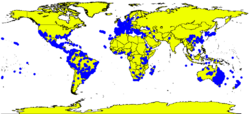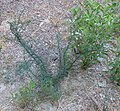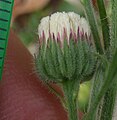Biology:Erigeron bonariensis
| Erigeron bonariensis | |
|---|---|

| |
| Scientific classification | |
| Kingdom: | Plantae |
| Clade: | Tracheophytes |
| Clade: | Angiosperms |
| Clade: | Eudicots |
| Clade: | Asterids |
| Order: | Asterales |
| Family: | Asteraceae |
| Genus: | Erigeron |
| Species: | E. bonariensis
|
| Binomial name | |
| Erigeron bonariensis | |

| |
| Occurrence data from GBIF | |
| Synonyms[1] | |
|
Synonymy
| |
Erigeron bonariensis is a species in the family Asteraceae, found throughout the tropics and subtropics as a pioneer plant; its precise origin is unknown, but most likely it stems from Central America or South America. It has become naturalized in many other regions, including North America, Europe and Australia .
Common names of E. bonariensis include flax-leaf fleabane, wavy-leaf fleabane, Argentine fleabane, hairy horseweed, asthma weed and hairy fleabane.[2]
Description
Erigeron bonariensis grows up to 75 cm (29.5 in) in height and its leaves are covered with stiff hairs, including long hairs near the apex of the bracts. Its flower heads have white ray florets and yellow disc florets. It can easily be confused with Erigeron canadensis, which grows taller, and E. sumatrensis.[3]
It flowers in August and continues fruiting until the first frosts. It is instantly recognisable by its blue-green foliage, very narrow, undulate stem-leaves, and purple-tipped involucral bracts. It reproduces only by seed, which are easily blown and spread by wind.[citation needed]
Distribution and habitat
Erigeron bonariensis is found throughout the tropics and subtropics as a pioneer plant; its precise origin is unknown, but most likely it stems from Central America or South America. It has become naturalized in many other regions, including North America, Europe and Australia .[4][5][6][7]
E. bonariensis is a rare alien in southeastern England , found along walls and in cracks in pavements and concrete driveways.[citation needed] It is widespread throughout Australia, where it thrives on roadsides, fallows, pastures, gardens, lawns, footpaths, parks, riparian vegetation, forest and wetland perimeters, waste dumps and disturbed grounds.[8][9]
Photographic Description
Dry Summer Form
- The following are bright dry summer 1st-year forms; in contrast to shady damp winter forms that follow.
Winter, Damp, Shady, Biennial Forms
- Showing diffusely branched or strangled appearances with small flower heads
Other photos
References
- ↑ Tropicos, Erigeron bonariensis L.
- ↑ {{citation | mode = cs1 | title = Conyza bonariensis | work = Germplasm Resources Information Network (GRIN) | url = https://npgsweb.ars-grin.gov/gringlobal/taxonomydetail.aspx?104170 | publisher = [[Organization:Agricultural Research ServAgricultural Research Service (ARS), United States Department of Agriculture (USDA) | access-date = 18 December 2017 }}
- ↑ Conyza bonariensis, International Environmental Weed Foundation
- ↑ Flora of China, Erigeron bonariensis L. 1753. 香丝草 xiang si cao
- ↑ Comprehensive profile for Conyza bonariensis , Malta Wild Plants
- ↑ Conyza bonariensis, Flowers in Israel
- ↑ Altervista Flora Italiana, Cespica di Buenos Aires, Erigeron bonariensis L. includes photos and European distribution map
- ↑ [1] Tall Fleabane by Agriculture of Victoria
- ↑ [2] Brisbane City Council Weed Identification Tool
Wikidata ☰ {{{from}}} entry
 |



















